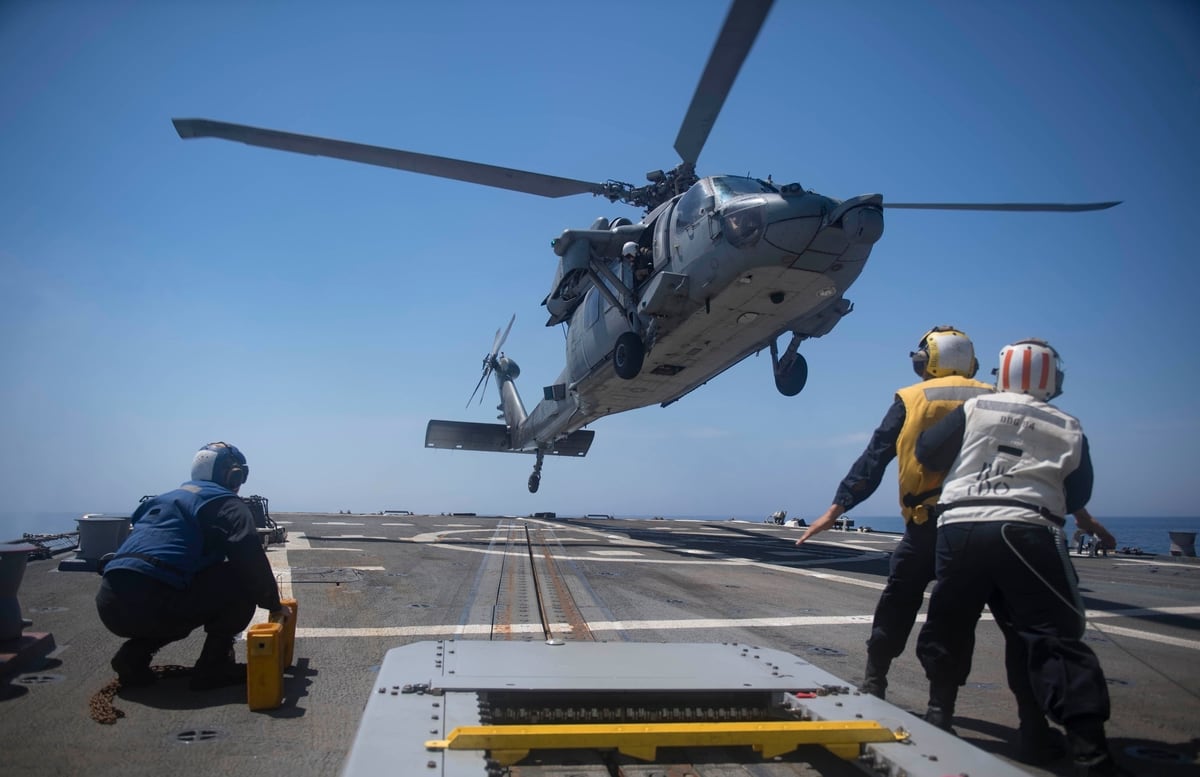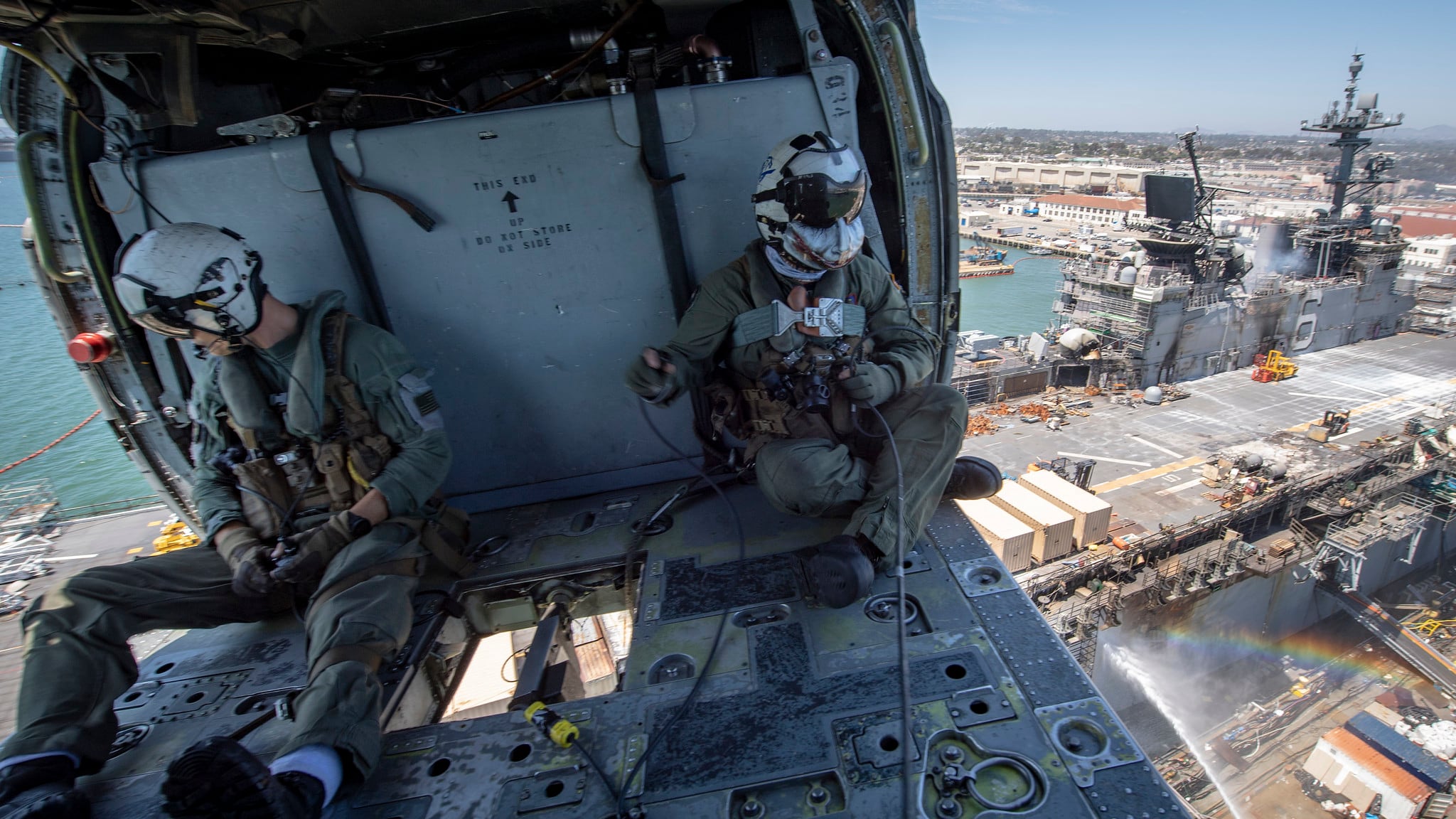The Aug. 31 crash of a MH-60S Seahawk helicopter in which five sailors died was caused by a damaged damper hose that failed, triggering massive vibrations just as the aircraft was landing, according to a Navy investigation into the mishap released this week.
The helicopter was conducting training aboard the aircraft carrier Abraham Lincoln 60 miles off San Diego that day when it touched down and began shaking intensely.
That sent the helo, known as Loosefoot 616, into a spin that saw its rotor blades fly off in several directions before the aircraft plummeted tail first into the ocean.
Those who died in the crash are Hospital Corpsman 3rd Class Bailey Tucker, Hospital Corpsman 2nd Class Sarah Burns, Naval Air Crewman (Helicopter) 2nd Class James Buriak, Lt. Paul Fridley and Lt. Bradley Foster.
A sixth crew member, an aviation warfare systems operator-helicopter 3rd class, or AWS3, was able to escape the helicopter after it hit the water and survived, according to the investigation.
His name is redacted in the copy of the investigation made public.
Go here to read the Navy’s command investigation.
The helicopter and the fallen sailors inside were recovered in October.
While investigators determined that the helicopter’s yellow damper hose failure caused the fatal sequence of events, they were unable to determine when or how the hose became damaged in the first place.
Its failure was due to the flattening of steel braid strands within the hose, a condition that can occur if the hose is kinked or bent a certain way, according to the investigation.
Safety teams suspect that the hose was bent or kinked during rotor head maintenance when it should have been disconnected as a spindle pry bar tool was used.
RELATED

“Prior to the mishap, there were likely no indications of an impending damper system failure as visual inspection of the damper hose would not uncover flattening of steel braid strands,” investigators wrote.
Failure of those steel braids is a progressive phenomenon, the investigation states, and damage would have continued to ensue with each flight hour.
“It is not possible to conclusively determine the timing or event that cause the damage due to many variables, one of which is that spindle pry bar use is not required to be documented,” the probe states. “Additionally, records dating back to 2011 do not document a yellow damper hose replacement and the flattening likely happened during a one-time event at some point.”
Within weeks of the fatal crash, the Navy directed a modification of spindle pry bar assemblies that would prevent using the tool in a way that would bend the damper hose, and such hoses were recommended for replacement on other helos.
Investigators found that pilots and maintainers in Loosefoot 616′s command, Helicopter Sea Combat Squadron 8, “took necessary and appropriate actions in response to prior damper hose failures,” and that at least 460 of the hoses had been replaced over the past five years in a fleet of 498 Navy H-60 aircraft.
Such hoses are not “high time” components, meaning they are not replaced after a given amount of flight hours but are instead swapped out when they show signs of wear or break, according to the investigation.
“Without indications of wear, vibration exceedances…or complete failures of the damper hoses, there was no reason or requirement to replace the two functional hoses,” investigators wrote.

Flattening of steel braids in the damper hose would not have been evident during external inspections that day.
“Any maintainers who performed external inspection to prepare (the helicopter) for flight on 31 August 2021, to include the maintainers performing the daily/turnaround inspections, and the (chief petty officer) who released the aircraft safe for flight, would not have known the hose was fatigued, or close to failure,” investigators wrote.
Investigators found no issues with the safety culture of Helicopter Sea Combat Squadron 8 or evidence of leadership failures, and the commander of Naval Air Forces, Vice Adm. Kenneth Whitesell, recommended no disciplinary action in relation to the fatal mishap.
Michael Canders, a retired military helicopter pilot, reviewed the investigation for Navy Times and said that an aircraft’s maintenance regimen evolves over its years in service.
Sometimes, he said, such issues aren’t found until tragic mishaps occur, said Canders, who currently serves as director of the Aviation Center at Farmingdale State College in New York.
“Aviation regulations or changes get written in blood,” Canders said. “It’s a terrible statement, but it does happen.”
Such aircraft are complex but also have a good safety record, he added.
Loosefoot 616 was delivered to the Navy in December 2011.

“As I read (the investigation), I thought, this is just one of those things that gets missed,” Canders said. “There’s a fatality before there’s a realization.”
Everything had been routine prior to the mishap, the surviving AWS3 told investigators.
But upon touching down on the Lincoln’s deck, the vibrations and noise exploded to a level at which the sailor recalled not being able to hear internal communications systems or the external radio calls.
“As the aircraft began to shake, flight deck personnel started moving backwards and sheltering behind crates, boxes and the tower,” the investigation states.
RELATED

As the helicopter rotated left and then right, one sailor reported seeing the aircraft’s blades detach and fly off in several directions before it fell off the side of the ship. Blade shrapnel struck personnel in the arresting gear officer pit about 200 feet aft of the carrier’s island.
An arresting gear officer was injured by debris in the mishap and medically evacuated from the ship. Two T-45 trainer aircraft also sustained damage, as did the deck’s flight safety nets and a signal locker.
Other sailors sustained minor injuries from debris.
“One witness who was on the flight deck at the time of the mishap stated that he ran to the deck edge after (the helicopter) went overboard, but was unable to see anything on the surface,” the investigation states.
The AWS3 did not recall losing consciousness during the harrowing event.
“Following water impact, he escaped from the left gunner’s window and swam to the surface as soon as he was able to get free from the helicopter,” the investigation states. “He estimates that he had to swim approximately 25 feet to reach the surface and recalled that the helicopter was oriented so that he was facing the surface as he egressed the window.”
Part of his job required rescue and survival swimming training.
He was soon rescued by sailors who had deployed a rigid hulled inflatable boat.
A search and rescue effort commenced for the next three days, but the other five sailors on board were not saved.
Geoff is the managing editor of Military Times, but he still loves writing stories. He covered Iraq and Afghanistan extensively and was a reporter at the Chicago Tribune. He welcomes any and all kinds of tips at geoffz@militarytimes.com.





